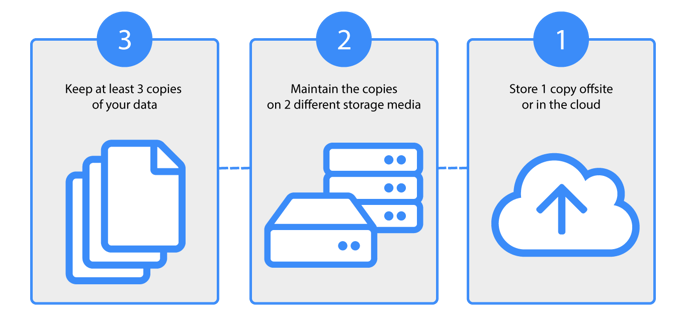Share this
How to Follow the 3-2-1 Backup Rule
by Bridget.Giacinto on Feb 28, 2023 4:14:00 AM

In a business, time is precious. Every minute lost due to downtime, results in lost revenue or possibly even closure. One security measure that can quickly restore productivity is your backup solution. It has the power to recover entire systems during a disaster scenario. It is the system administrators "ace in the hole" when all other security technologies fail. It only works however, if a reliable and restorable backup is accessible during a time of crisis. There are guidelines which can help to ensure this, the most popular being: the 3 2 1 backup rule.
What does it entail?
Although this precedent may not be discussed specifically within compliance or business regulations, it has become the minimum standard for backup strategies and will facilitate your recovery. It will get your organization back up and running in the event of a breach, and several other types of increasingly common threats that cause downtime. The 3 2 1 backup rule states that you should:
- Have 3 copies of your data
Copies should be in the form of secure, encrypted backups - Stored on 2 different types of media
Examples: Solid State Drive, Magnetic Disk Drive, Flash Media, Magnetic Tape, etc. - With 1 backup kept off-site
A cloud backup for your off-site requirement can create better accessibility.
The beauty of this 3-2-1 backup rule is that it's simple for everyone to understand and easy to maintain. It is one of the ways to ensure that backups are always restorable and that organizations always have a copy of their resources available during a disaster.
Cloud-based storage has made it far more convenient and affordable to diversify and access your backup storage devices and locations (For example: Backup to a NAS device at a different physical office).
Benefits of 3 2 1 Backup Rule
Besides its simplicity, this rule has numerous other business benefits. For one, the redundancy ensures that when one copy is destroyed or otherwise unavailable, there are other backup copies accessible. This will increase your organization's chances of getting your systems back online in a reasonable amount of time and help mitigate such a disaster's effects.
The 3 2 1 rule also allows you to customize the specifics in a way that best suits your organization's needs. You can utilize any supported and reliable storage media that you like, and select whichever vendor will best support you and cater to your off-site requirements.
Virtual Machines
These days most organizations are utilizing virtual machine technology in one way or another, and the 3 2 1 rule can play an important role here. It's not unheard of for a VM to become corrupt and require some data restoration. Your backup solution should be able to capture VM's at different points in time, with the ability to restore specific files as needed. Having backup data stored in multiple locations creates the flexibility to quickly access specific lost data, possibly preventing the need to spend time rebuilding the entire machine.
Follow the details
"Make sure that your backups are successfully following these guidelines."
Because the 3 2 1 rule explicitly states the steps you should take to secure your data, make sure that your backups are successfully following these guidelines. As InformationWeek contributor Doug Hazelman pointed out, although 3 2 1 is an effective strategy, there have been some high-profile cases that have failed to adhere to the details stated within the rule.
For example, Pixar almost lost "Toy Story 2" due to failed backups and a rogue command. Luckily, someone had saved a third copy to a home computer off-site, mitigating the potential damage. This instance shows just how important the redundancy is within the 3 2 1 rule.
"The 3 2 1 rule sounds easy when you first think about it, but the devil is in the details," Hazelman wrote. "As the producers of 'Toy Story 2' no doubt learned, it can be all fun and games until a backup is missing - then things can get awfully serious."
Want to take your backup strategy to the next level? Download our free Backup Strategy Guide.
Share this
- Pre-Sales Questions (109)
- Tips and Tricks (99)
- Industry News (56)
- Reseller / MSP (38)
- Best Practices (33)
- Security Threats / Ransomware (29)
- Disaster Recovery (26)
- Applications (25)
- Cloud Backup (24)
- Storage Technology (23)
- Backup Videos (22)
- Compliance / HIPAA (22)
- Virtual Environments (17)
- Technology Updates / Releases (9)
- Infographics (8)
- Backup preparation (5)
- Products (US) (3)
- Company (US) (1)
- Events (1)
- Events (US) (1)
- April 2025 (2)
- March 2025 (1)
- February 2025 (2)
- January 2025 (2)
- December 2024 (1)
- November 2024 (1)
- October 2024 (1)
- September 2024 (2)
- August 2024 (1)
- July 2024 (2)
- June 2024 (2)
- May 2024 (1)
- April 2024 (2)
- March 2024 (2)
- February 2024 (2)
- January 2024 (1)
- December 2023 (1)
- November 2023 (1)
- October 2023 (1)
- September 2023 (1)
- August 2023 (1)
- July 2023 (1)
- May 2023 (1)
- March 2023 (3)
- February 2023 (2)
- January 2023 (3)
- December 2022 (1)
- November 2022 (2)
- October 2022 (2)
- September 2022 (2)
- August 2022 (1)
- July 2022 (1)
- June 2022 (1)
- April 2022 (1)
- March 2022 (2)
- February 2022 (1)
- January 2022 (1)
- December 2021 (1)
- November 2021 (1)
- September 2021 (1)
- August 2021 (1)
- July 2021 (1)
- June 2021 (1)
- May 2021 (2)
- April 2021 (1)
- March 2021 (2)
- February 2021 (1)
- January 2021 (1)
- December 2020 (1)
- November 2020 (1)
- October 2020 (1)
- September 2020 (4)
- August 2020 (2)
- July 2020 (1)
- June 2020 (1)
- May 2020 (1)
- April 2020 (1)
- March 2020 (3)
- February 2020 (2)
- January 2020 (2)
- December 2019 (1)
- November 2019 (1)
- October 2019 (1)
- August 2019 (1)
- July 2019 (1)
- June 2019 (1)
- April 2019 (1)
- January 2019 (1)
- December 2018 (1)
- November 2018 (2)
- August 2018 (3)
- July 2018 (4)
- June 2018 (2)
- April 2018 (2)
- March 2018 (2)
- February 2018 (2)
- January 2018 (3)
- December 2017 (1)
- September 2017 (1)
- May 2017 (2)
- April 2017 (5)
- March 2017 (4)
- February 2017 (1)
- January 2017 (1)
- December 2016 (1)
- November 2016 (1)
- October 2016 (2)
- September 2016 (1)
- August 2016 (3)
- July 2016 (2)
- June 2016 (2)
- May 2016 (7)
- April 2016 (8)
- March 2016 (1)
- February 2016 (2)
- January 2016 (12)
- December 2015 (7)
- November 2015 (5)
- October 2015 (6)
- September 2015 (1)
- August 2015 (2)
- July 2015 (2)
- June 2015 (2)
- May 2015 (1)
- April 2015 (4)
- March 2015 (3)
- February 2015 (4)
- January 2015 (2)
- October 2014 (4)
- September 2014 (8)
- August 2014 (5)
- July 2014 (7)
- June 2014 (3)
- May 2014 (3)
- April 2014 (9)
- March 2014 (7)
- February 2014 (7)
- January 2014 (5)
- December 2013 (4)
- October 2013 (7)
- September 2013 (2)

